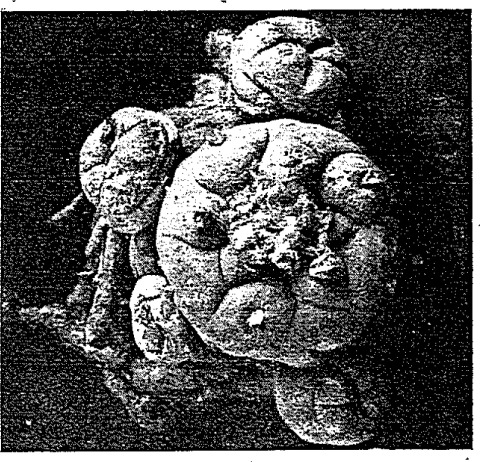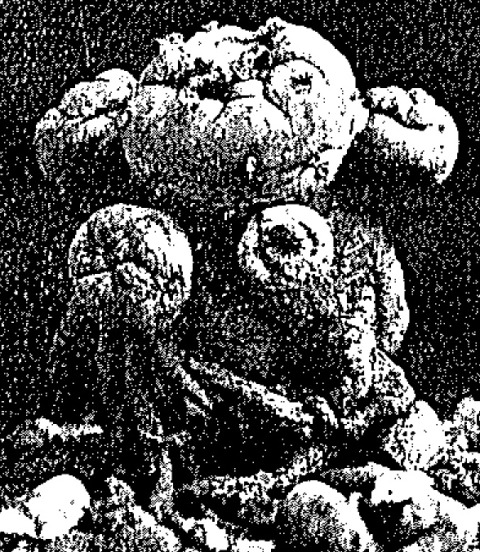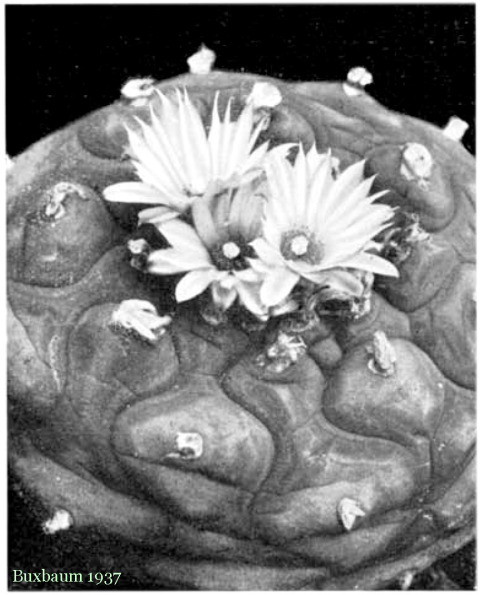Care should be taken in this area.
Lophophora echinata Croizat var. lutea (Rouhier) comb. nov.
aka Echinocactus williamsii var. lutea
There are also the names Lophophora diffusa var. lutea, Lophophora texana var. lutea and Lophophora williamsii var. lutea appearing in horticulture.
“A var. typica flore saltem luteo recedit.”
“The new combination is based upon Rouhier’s Echinocactus Williamsii var. lutea. (in Trav. Lab. Mat, Med. Pharm. Fac. Paris 17 [5]: 62-65 fig. 31. 1927).”
Croizat 1944.
Lophophora Tiegleri and Lophophora Ziegleri, also typically just refer to horticultural Lophophora diffusa.
Similarly Lophophora Ziegleriana, which will be mentioned only briefly later.
Lophophora lutea
This is a name that is still encountered in horticultural offerings.
This currently is most often L. diffusa and is usually in reference to a yellowish body color on the plants. (Lutea is from the Latin; Luteus: “Yellow”).
The original ‘description’ by Alexandre Rouhier included reference to a yellow flower color on what he presented to be Echinocactus Williamsii, which is not demonstrated to be linked to any distinct population.
MS Smith points out that if flower color alone is used to assign this name, then L. diffusa would remain the most likely candidate for cultivated plants.
More comments can be found above.
The opinion expressed by Helia Bravo was that *all* reports claiming yellow flowers on L. diffusa (which includes a fair number of people in Europe AND commercial offerings) were simply white flowers that had become dusted with pollen. The publication of photographs in black and white and the *commercial offerings of yellow-flowered plants* since the early part of the last century, or at least plants sold with the name sp. luteiflora, both suggest that yellow flowered Lophophoras exist but that is clearly tempered by their near absence in published or in online photographs.
Pizzetti 1985 includes a color picture (without a flower) claimed to be this “species” (entry #153). Pizzetti states that it has also been called L. ziegleri and is differentiated from L. williamsii by having “scarcely tuberculate ribs divided by winding grooves, yellowish down, and larger, pale yellow flowers”.
In my experience the felt color of L. williamsii has been observed to be highly variable and is not infrequently yellowish, sometimes very much so.
It has commonly been said that Rouhier’s yellow flower was in error. That may be yet I have witnessed at least one, if not more, individual of Lophophora williamsii with distinctly pale yellow flowers in the Texas populations. Clearly those have been a rarity. Some years ago I actually ceased mentioning this to people simply due to becoming bored with those people who wanted to argue that I had never seen this. I certainly can’t prove it since those plants crossed my path more than 30 years ago but it is what it is.
It IS noteworthy however that in all of the photographs of Lophophoras that were recently locateable using Google images one of those appeared to have a flower that might actually be a light yellow but could simply have been white and catching a bit of reflected color from adjacent yellow hairs. I can only locate one single color image with a flower that is clearly pale yellow. I’d assume that image to be of a Lophophora diffusa. The relative dearth of color images showing yellow flowered Lophophoras should not be trivialized as it supports this to be a rare phenomenon.





